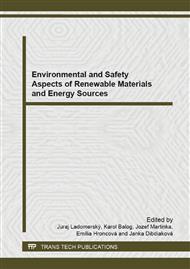[1]
Mózer, V., Osvald, A., Loveček, T. Fanfarová, A., Vrábľová Ľ.: Fire safety in tunnels forming part of critical infrastructure [Požiarna bezpečnosť tunelov tvoriacich súčasť kritickej infraštruktúry]. In ICCST 2013 : 47th IEEE International Carnahan Conference on Security Technology: Medellin, 2013, Colombia. 978-958-8790-65-7.
DOI: 10.1109/ccst.2013.6922042
Google Scholar
[2]
Rantuch P, Kačíková D, Nagypál B. Investigation of activation energy of polypropylene composite thermooxidation by model-free methods. European Journal of Environmental and Safety Sciences. Vol. 2 (2014), pp.12-18. ISSN 1339-472X.
Google Scholar
[3]
Ružinská E, Mitterová I, Osipiuk J.: Proposal of the experimental determination of selected characteristics degradation of wood material modified by coatings with the occurence of risk substances. In WULS- SGGW, For. And Wood Technol. 84, (2013).
Google Scholar
[4]
Ružinská E.: The study of thermal characteristics of modified products isolated from kraft black liquor for formulation of new type of adhesive mixtures. In Wood research 48 (1/2): (2003).
Google Scholar
[5]
Xu Q, Majlingova A, Zachar M, Jin C, Jiang Y.: Correlation analysis of cone calorimetry test data assessment of the procedure with tests of different polymers. Journal of Thermal Analysis and Calorimetry an International Forum for Thermal Studies. 110/1. 2012. ISSN 1388-6150.
DOI: 10.1007/s10973-011-2059-7
Google Scholar
[6]
Xu Q, Majlingova A, Zachar M, Jin C, Jiang Y.: Evaluation of plywood fire behaviour by ISO tests. Europen Journal of Environmental and Safety Sciences. (1/1): 1-7. (2013).
Google Scholar
[7]
Košík, M. et al. 1986. Polymérne materiály a ich požiarna ochrana. (Polymeric Materials and Their Fire Protection) Bratislava: ALFA, p.54.
Google Scholar
[8]
Osvald, A.: Požiarno-technické vlastnosti dreva a materiálov na báze dreva (Fire-technical Characteristics of Wood and Wood-Based Materials), 8/97/A, ES TU Zvolen, 1997, ISBN 80-228-0656-0.
Google Scholar
[9]
Harangozó, J., Sledovanie vplyvu retardérov horenia na proces iniciácie plameňového a bezplameňového horenia tuhých materiálov(Study of the Effects of Flame Retardants on the Initiation Process of the Flame and Flameless Combustion of Solids), Dissertation, Trnava, (2011).
DOI: 10.26552/krm.c.2023.1.22-27
Google Scholar
[10]
Draxlerová, M., Vplyv retardérov na iniciáciu horenia tuhých materiálov (Effects of Retardants on the Ignition of Solid Materials), Diploma Work, Trnava, (2013).
Google Scholar


